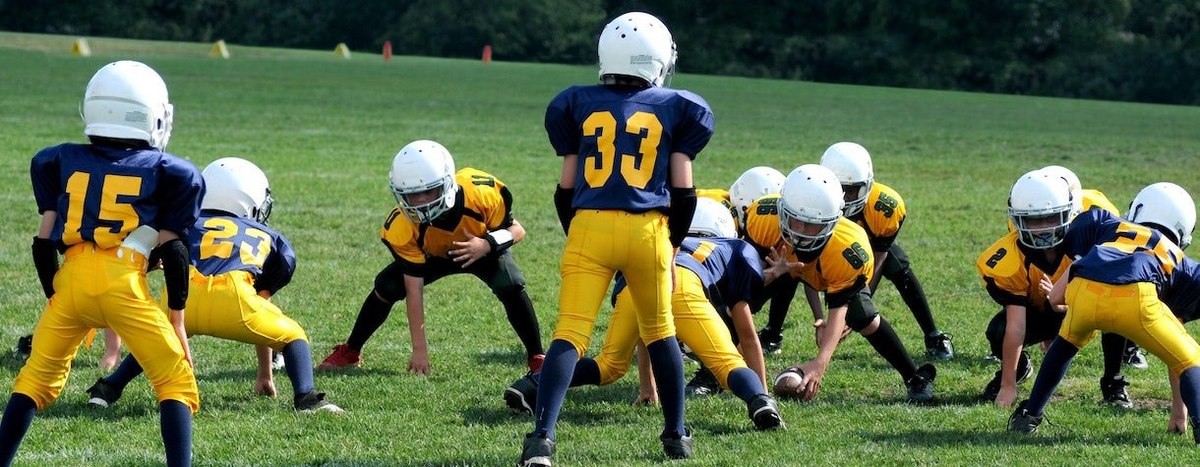Sports play an outsize role in the lives of many American children, providing them with an outlet for pent-up energy, a place to build friendships, and a source of important life lessons. At the same time, youth sports also involve risk, including the risk of disappointment over losing or not making the cut, as well as the risk of short- and long-term injuries. A series of recent YouGov polls asked American adults to share details of their experiences with sports growing up, including which sports they played, how sports made them feel, and whether they were ever injured. The results show that youth sports were a positive experience for most Americans who participated in them, and many see the benefits of sports for children overall as outweighing the potential risks.
How many Americans participated in youth sports?
Two-thirds (65%) of American adults say they participated in a recreational or competitive sport before they turned 18. Men and women have different experiences when it comes to youth sports: While 76% of men engaged in sports as a child or teenager, only 55% of women did. Older adults are slightly more likely to say they participated in youth sports than younger adults are.
Which youth sports did Americans participate in?
While the poll asked about 37 sports, we present results on only the 15 most common sports polled, each of which at least 4% of Americans say they played. Of these, the top two most popular sports — each played by about one in four Americans when they were kids — are basketball (24%) and baseball (23%). One reason why basketball is nearly overshadowed by baseball is that baseball's female-dominated cousin, softball, was polled separately; combined, 37% of adults say they played either baseball or softball.
Gender plays a prominent role in which sports Americans gained experience in while growing up. For men, the top three youth sports they played are baseball (played by 40%), basketball (32%), and football (31%); all other sports pale in comparison to these three. Women's experiences are more evenly distributed among a variety of sports. The top three youth sports that were played by women are volleyball (17%), basketball (16%), and softball (16%).
At what age do Americans typically start playing sports?
Among Americans who participated in sports in their youth, only 13% say they began playing when they were age 5 or younger. Two-thirds of adults who played youth sports started between the ages of 6 and 9 (30%) or 10 and 13 (38%). Roughly one in five (17%) say they started when they were older — between the ages of 14 and 17. Our data suggests that Americans are playing sports at younger ages now than in the past: One in four Americans under the age of 45 (23%) say they began playing sports at age 5 or younger compared to only 6% of people who are 45 or older.
What role do Americans' parents play in their youth-sports participation?
When asked about the role their parents played in their participation in youth sports, American adults are most likely to say that their parents encouraged them to play sports, but did not make them play (42% say this); only 5% say their parents made them play. Many (40%) say their parents had no influence on their decision to play sports, and just 8% say their parents either discouraged or banned them from playing.
Men are 20 percentage points more likely than women to say their parents encouraged them to play sports, but did not make them (53% vs. 33%). Women are more likely than men, by a similar margin, to say their parents had no influence on their decision to play sports (50% vs. 29%). People who played youth sports are far more likely than people who did not play sports to say their parents encouraged them to play (58% vs. 10%). Around one in 10 people who did not play youth sports say their parents did not allow them to play.
We also look at how responses to this question differ based on which sport Americans say they played growing up. People who played soccer or tennis are most likely to say their parents made them play sports, though still only around one in 10 who played each of these sports say this. However, at least half of people who played each of the 15 sports analyzed say their parents encouraged them to play. Americans who participated in youth soccer (75%), swimming/diving (70%), cross country (70%), or baseball (69%) are most likely to say their parents either encouraged them to play or made them play.
Did Americans enjoy their experiences with youth sports?
Americans who participated in youth sports are far more likely to say their memories of the sports were mostly good than to say they were mostly bad. Nearly two-thirds of people say their memories of youth sports are either all (32%) or mostly good (33%). One in five (21%) say they were equally good and bad, and only 11% say they were all or mostly bad. American adults under 30 are less likely to hold mostly positive memories of their childhood athletic experiences; they're around half as likely as people 45 and older to say their experiences were nearly all good, though few in either group say they were mostly bad.
The poll also asked Americans about the quality of their experiences participating in specific sports. Below, we present the results from the 15 most popular sports, with responses ranging from very positive to very negative. Majorities of Americans reported very or somewhat positive experiences with each of the 15 sports, and fewer than one in five reported negative experiences with any individual sport.
Americans who participated in dance during their youth are most likely to say their experiences dancing were positive: 53% say they were very positive and 31% say somewhat positive. Youth sports following closely behind dance in terms of the share of people reporting positive experiences are bowling (52% very positive, 28% somewhat positive), volleyball (48%, 30%), and tennis (43%, 32%). Americans who participated in youth wrestling are the least likely to say they enjoyed the sport, though far more still say their experiences were overall positive (65%) than negative (19%).
Looking back on their own experiences with youth sports, most people who played them say they were fun (64%) and helped them stay physically active and healthy (58%) when given the choice of any of eight statements that could describe their experience. Almost half say sports helped them make friends (47%) and 41% say sports taught them important life lessons. Far fewer say more negative statements about youth sports: that sports were too much of a time commitment (12%), were too competitive (11%), led to injuries (8%), or were a waste of money (6%).
Of the 15 sports analyzed, people who participated in soccer, wrestling, and volleyball are the most likely to describe their experiences playing sports as fun. Soccer and wrestling also top the list of sports whose former youth players describe sports as helping them stay physically active and healthy. The sports played by Americans who were most likely to say that sports helped them make friends are cross country, cheerleading, and wrestling. The fewest share of former youth athletes who say sports helped them make friends are former gymnasts. The largest share of people who say that sports taught them important life lessons are people who played football, track and field, and soccer when they were kids.
Which youth sports are most likely to result in injuries?
One worry that accompanies youth sports is the risk of injury. Many people say they experienced sports-related injuries in their youth, though for the most part they say the injuries were minor ones. Of the 15 most popular youth sports in the poll, football is the most likely to have produced injuries for people who played it in their youth: 59% say they received at least minor injuries playing football, including 13% who say their injuries were major. Half of Americans who say they played youth soccer (52%) were injured in some way, and slightly fewer received injuries participating as young people in wrestling (43%), basketball (42%), and gymnastics (40%). The three sports of the 15 that appear least likely to result in injuries are bowling (17%), swimming or diving (18%), and tennis (19%).
One thing to consider is that a person's likelihood of being injured in a given sport at any time is in part a function of how long they participated in the sport — and not only the risk of injury in any given day or year of participation.
Are kids safer playing sports today than they were in the past? Some think so, but overall few believe kids' sports are dangerous now or in their youth. Two-thirds of Americans think youth sports today are very (25%) or somewhat safe (41%), while 21% think they are very or somewhat dangerous. Thinking back to when they were growing up, slightly fewer say sports were very (18%) or somewhat safe (43%), and 24% say they were very or somewhat dangerous. While Americans' give higher safety marks to youth sports today, somewhat paradoxically older adults are more likely to describe youth sports when they were growing up as safe than younger adults. The effect is mostly driven by younger adults who didn't play youth sports rating sports as much less safe than non-athletes from prior generations.
How many Americans feel they're naturals at sports?
Some people feel like natural athletes, while others have to work a little harder to get the same results. A little more than half of Americans who participated in youth sports (54%) say that playing sports comes naturally to them, while 34% say it does not come naturally. Men with experience in youth sports (59%) are more likely than women (48%) to believe they're naturals when it comes to sports.
Some people get a rush from playing sports, while others feel tired or frustrated. We asked Americans with experience in youth sports to select all that apply from a list of 10 positive and negative adjectives describing how they feel when playing sports. By far the most frequently selected descriptor, chosen by 58% of people, is "satisfying." The next two most commonly selected words – "exhilarating" (37%) and "empowering" (33%) – are also positive ones. Only 6% of people say they find playing sports to be "boring" and 19% say they find them "frustrating."
People who see themselves as naturals when it comes to sports have far different experiences with sports growing up than people who feel they lack natural athleticism. Among people who participated in youth sports and say playing sports comes naturally to them, 74% find sports satisfying to play, compared to just 40% of people who don't say sports come naturally to them. Self-described naturals at sports are also more likely than people who don't describe themselves that way to say sports are exhilarating (47% vs. 22%), empowering (43% vs. 22%), and inspiring (43% vs. 15%). Adults who see themselves without a sporty nature are more likely than people who do to say they feel exhausted (36% vs. 20%), frustrated (30% vs. 12%), or bored (11% vs. 3%) when playing sports.
What effect does playing sports have on kids?
We also distilled common beliefs about youth sports into brief statements and measured the extent to which Americans agree or disagree with each one. While there are drawbacks to agree/disagree-style questions, when used in a series they can be useful for comparing attitudes to a set of ideas.
The vast majority of people agree that youth sports help kids stay active (90% agree), make friends (86%), develop social skills (85%), and learn important life lessons (80%). Americans are more divided as to whether youth sports are too competitive (48% agree vs. 40% disagree), result in unnecessary injuries (46% vs. 39%), or are too big of a time commitment (40% vs. 44%). A majority (58%) disagree that youth sports are too expensive and a waste of money.
— Carl Bialik and Linley Sanders contributed to this article.
The poll was conducted among 2,000 U.S. adult citizens in two waves on two separate surveys conducted from August 1 - 2, 2022 and August 8 - 11, 2022, with each survey conducted among 1,000 U.S. adult citizens. Explore more on the methodology and data for this poll.
Image: Unsplash (Ben Hershey)










